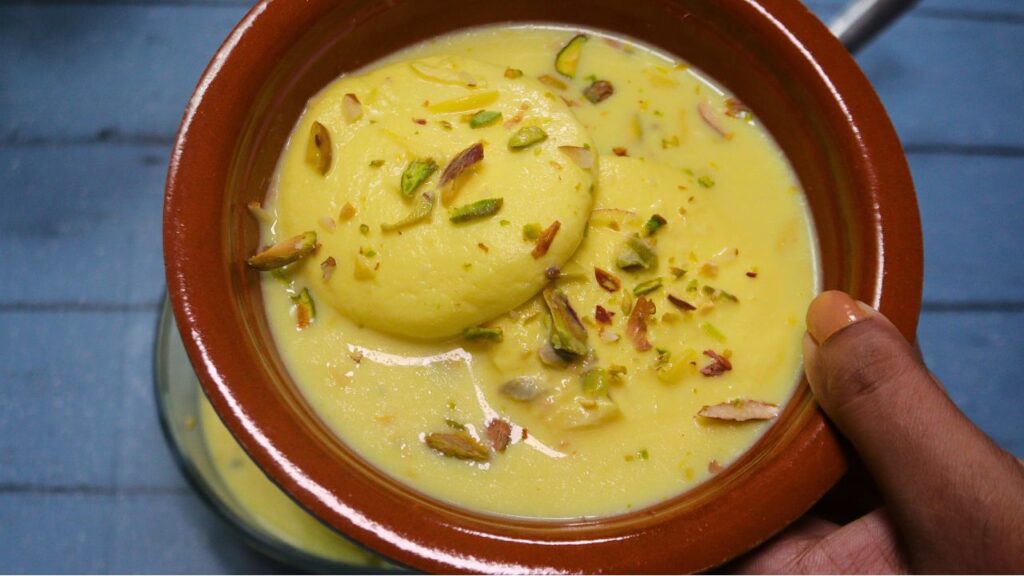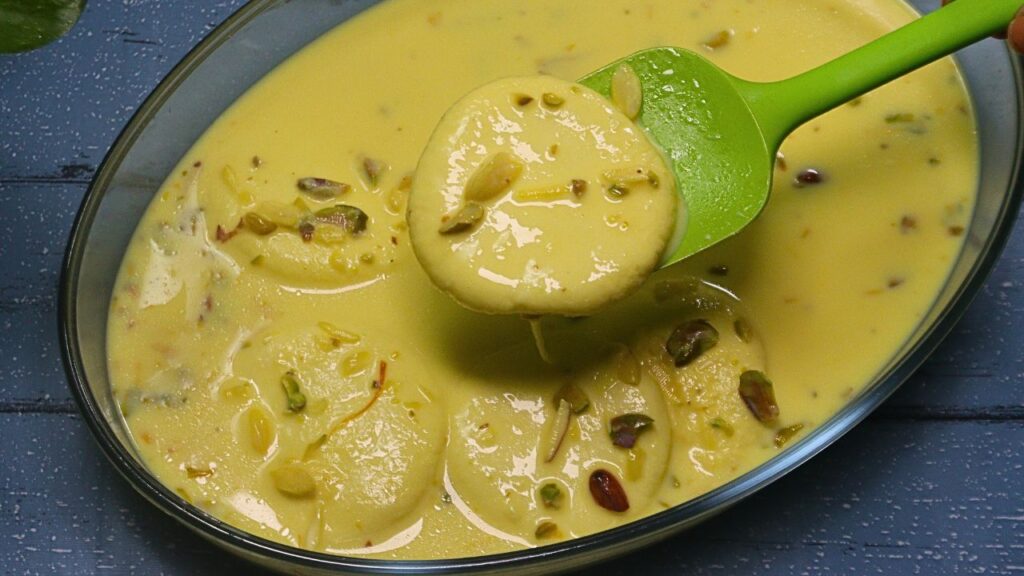



Rasmalai, often hailed as the “queen of Indian desserts,” is an iconic sweet dish enjoyed across India and beyond. This dessert is characterized by its soft, spongy chenna (curdled milk) discs immersed in a fragrant and creamy milk-based syrup called rabri. Made with simple ingredients such as milk, sugar, saffron, and nuts, Rasmalai represents the richness and subtlety of traditional Indian sweets. It is popular at weddings, festivals, and special occasions, making it a true symbol of celebration.

The word Rasmalai is derived from two Hindi words: "ras," meaning juice or syrup, and "malai," which means cream. This dessert, therefore, literally translates to “creamy syrup” and reflects the silky smooth texture and delicate flavors that it offers. Rasmalai belongs to the broader family of Bengali sweets, along with dishes like Rasgulla, which share a similar chenna base. However, Rasmalai stands out for its richer, more indulgent rabri base, which is infused with aromatic saffron and cardamom.
The origins of Rasmalai can be traced to the eastern parts of India, particularly Bengal and Odisha, where making sweets from chenna is a traditional art form. Over time, Rasmalai has found its way into the hearts of people across India, becoming a popular dessert choice for festivities like Diwali, Holi, and Raksha Bandhan. Its luxurious yet comforting nature makes it a favorite at weddings and family celebrations.
The key ingredients in Rasmalai include milk, vinegar (or lemon juice), sugar, and cardamom powder. These elements combine to create a dish that is both flavorful and texturally satisfying. The process involves curdling the milk to prepare the chenna, which is then kneaded, shaped into discs, and cooked in a light sugar syrup. The discs are subsequently soaked in rabri—a thickened milk flavored with saffron and cardamom—to create the complete dessert.
Chenna, or paneer, forms the base of Rasmalai. It is made by curdling fresh milk with vinegar or lemon juice, separating the curds from the whey. The curds are then gathered in a muslin cloth, squeezed to remove excess moisture, and rested for a while. Properly prepared chenna is soft, moist, and pliable, which helps achieve the characteristic spongy texture of Rasmalai.
Rabri is the creamy, fragrant milk base in which the chenna discs are soaked. It is made by reducing full-fat milk and adding saffron strands, cardamom powder, and a touch of sugar. The rabri not only enhances the flavor of the dessert but also adds a luxurious, velvety texture that makes Rasmalai so delightful. It is common to garnish the rabri with chopped almonds and pistachios, adding a subtle crunch to each bite.
Preparing Rasmalai is both an art and a science, requiring precision and patience. The key steps involve:
One of the most captivating aspects of Rasmalai is its visual appeal. The vibrant yellow color of the rabri, achieved with saffron strands, contrasts beautifully with the white chenna discs. The garnishing of chopped nuts adds a touch of elegance, making Rasmalai a feast for the eyes as well as the taste buds.
The aroma of saffron and cardamom, combined with the creaminess of rabri and the spongy chenna, creates a multi-layered sensory experience. Every bite of Rasmalai delivers a delicate sweetness balanced with the mild, fragrant notes of cardamom.
While Rasmalai is undeniably a dessert, it does offer some health benefits due to its primary ingredients:
However, as with most sweets, it’s important to enjoy Rasmalai in moderation due to its sugar and fat content.
While the traditional recipe remains a favorite, several variations of Rasmalai have gained popularity:
Rasmalai is typically served chilled, allowing the rabri to thicken slightly and the flavors to meld. It is best enjoyed as a standalone dessert, although it can be paired with other Indian sweets like Rasgulla or Sandesh for a lavish dessert spread. In North India, it is often served at the end of festive meals, alongside dishes like biryani or pulao.
Rasmalai’s soft texture, balanced sweetness, and luxurious feel make it a perfect dessert for celebrations. It symbolizes indulgence and joy, making it a popular choice for festive occasions like Diwali, Holi, and Eid. The preparation of Rasmalai also reflects the time-honored tradition of Indian sweet-making, where every step is infused with care and attention to detail.

In conclusion, Rasmalai is more than just a sweet dish—it is a representation of India’s rich culinary heritage. The combination of soft chenna discs and creamy rabri, flavored with saffron and cardamom, creates a dessert that is both comforting and luxurious. Its popularity at weddings, festivals, and family gatherings speaks to its status as a beloved Indian dessert.
Whether you enjoy the traditional version or experiment with modern variations, Rasmalai offers a unique blend of textures and flavors that make every bite a delight. It is a testament to the art of Indian sweet-making, where simplicity and elegance come together to create something truly special.
Begin by preparing the key ingredient of Rasmalai—chenna. To do this, mix 2 tablespoons of vinegar with an equal amount of water. This diluted vinegar will help curdle the milk gently. Take 1 liter of milk and bring it to a boil in a large pan. Once the milk starts boiling, turn off the flame and gradually add the diluted vinegar mixture in small batches while stirring continuously. As soon as the milk curdles and separates into greenish whey and chenna, you’ll know it’s ready. This separation is crucial for creating the soft chenna base.
To remove the acidity and further separate the chenna from the whey, pour 2 cups of cold water into the pan. Strain the mixture using a muslin cloth, catching the chenna in the cloth and allowing the whey to drain away. Once the chenna is separated, squeeze it gently to remove excess water, but not too forcefully to keep some moisture. Let it rest for around 20 minutes, allowing the chenna to firm up slightly.
While the chenna rests, it’s time to prepare the rich and creamy rabri, which will be the base of the Rasmalai. In a separate pan, take 1 liter of milk and bring it to a boil. Once it reaches a rolling boil, reduce the flame to a simmer. Add a pinch of saffron strands, which will impart a mild yellow color and a delightful aroma. Enhance the flavor by adding chopped pistachios, almonds, 0.25 cup of sugar, and 0.5 teaspoon of cardamom powder. These ingredients not only sweeten but also add depth and texture to the rabri.
If you prefer a more vibrant appearance, you can also add 2 drops of yellow food coloring, though this is entirely optional. Simmer this mixture on low heat for about 5 minutes until it thickens slightly and turns fragrant. Once done, switch off the flame and set the rabri aside to cool.
After the chenna has rested for 20 minutes, transfer it to a flat surface like a large plate or a kitchen counter. Begin mashing the chenna with the heel of your palm, rubbing it gently against the surface until it turns into a smooth, pliable dough. This step is crucial for achieving the characteristic softness of the Rasmalai. Continue kneading until the chenna is smooth and free of lumps.
Once the desired consistency is achieved, add 1 teaspoon of corn flour to the chenna. This acts as a binding agent and helps in giving structure to the chenna balls, preventing them from falling apart while cooking. Mix the corn flour thoroughly with the chenna. Now, take small portions of the chenna mixture and roll them between your palms to form smooth balls. Slightly flatten the balls into discs and set them aside.
The next step is to prepare the sugar syrup or liquid to cook the chenna discs. In a large, wide pan, bring 4 cups of water to a boil and add 1 cup of sugar. Allow the syrup to come to a steady boil while stirring to dissolve the sugar completely.
Once the sugar syrup reaches a rolling boil, gently drop the prepared chenna discs into the boiling syrup. Cover the pan and let the chenna discs cook in the syrup for about 10-15 minutes. During this time, the chenna will absorb the syrup and expand, almost doubling in size.
After the chenna discs have finished cooking, carefully transfer them into a bowl of cold water. This step is important as it stops the cooking process and helps retain the shape of the chenna. Squeeze out excess water from each disc by pressing them lightly between your palms. Now, the chenna discs are ready to be soaked in the prepared rabri.
Gently place the chenna discs into the cooled rabri and allow them to soak for 2-3 hours. During this time, the chenna will absorb the flavors of the saffron-infused rabri, turning soft, spongy, and flavorful.
After the soaking period, your delectable Rasmalai is ready to be served. Garnish the dish with a few more chopped nuts like pistachios and almonds for an elegant touch. Serve the chilled Rasmalai in shallow bowls, making sure each portion gets an ample amount of the creamy rabri and a few discs of chenna.